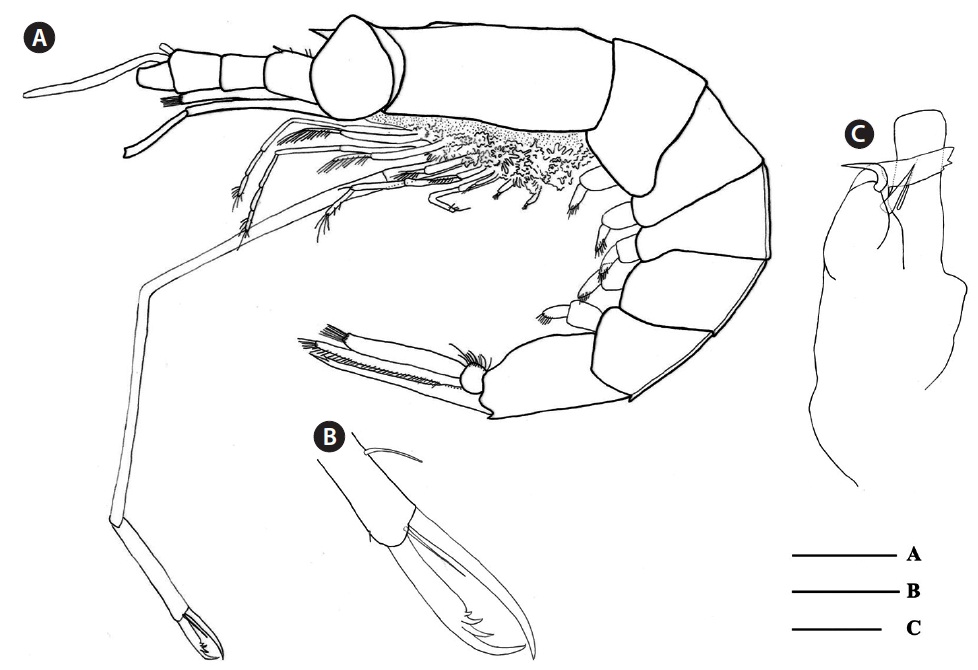



The euphausiid crustacean Stylocheiron abbreviatum G. O. Sars, 1883 has been found in the southern waters of Jeju Island, Korea. This species is the third member of the genus Stylocheiron and the twelfth of the family Euphausiidae identified in Korean waters. Using descriptions of this species, a key to Korean euphausiids is presented.
Eupahusiid crustaceans are of major importance in temperate and polar oceans, where they support the food web of phytoplankton, fishes, birds, and marine mammals (Mauchline 1980). The order Euphausiacea comprises two families: Bentheuphausiidae and Euphausiidae. The family Bentheuphausiidae has only one species,
During the course of a zooplankton survey in the southern waters of Korea, a male
Zooplankton samples, from which a male specimen of
Stylocheiron abbreviatum G. O. Sars, 1883 (
220-221, figs. 118, 124f.
Male: Body length 13 mm. Eye with upper lobe somewhat pyriform in appearance, much smaller than lower lobe; facets of upper lobe larger than those of lower, but crystalline cones not conspicuously enlarged. Frontal plate produced as slender rostrum reaching barely beyond the anterior limit of eyes. Gastric region of carapace domed, with a small median keel (Fig. 1A). Third thoracic leg elongated with a true chela. The distal 1/3 of dactylus modified into three teeth or pectinate indentations (Fig. 1B). Third to fifth segments of the abdomen with low mid-dorsal keels. Sixth segment length/depth ratio 1.9. Petasma with strong terminal process, somewhat hollowed distally; proximal process shorter, more slender and tapering throughout its length; lateral process curved, slender, nearly equal in length to proximal process (Fig. 1C).
Female: Not found in this study.
This species is an offshore warm-water species, and is usually found at latitudes between 40°N and 40°S in the Pacific Ocean (Brinton 1962). This species also occurs in the tropical and subtropical waters of the Indian Ocean and the Atlantic (Boden et al. 1955). In the Korean waters, Hong (1969) recorded two species of
>
Key to Euphausiidae species from Korean waters
1. Thoracic legs nearly uniform in structure. ·····················2
Thoracic legs unequally developed, one or two of the anterior pairs of legs being greatly elongated. ······················ 9
2. Distal three segments of sixth thoracic legs greatly reduced. ······························································ 3 (
Sixth thoracic leg similar in appearance to fifth. ··············· ······································································ 4 (
3. Mandibular palp present. ····························
Mandibular palp absent. ········································
4. Species with two pairs of lateral denticles on the carapace. ·· 5
Species with one pair (rarely none) of lateral denticles on the carapace. ··································································· 6
5. No process on second antennular segment. ··········
Second antennular segment with a spine and tubercles. ······· ·············································································
6. Hind margins of first and second abdominal segments straight dorsally. ··························································· 7
Hind margins of first and second abdominal segments dorsally with a produced rounded part. ··················
7. Antennular lappet developed in both male and female. ···· 8
Antennular lappet absent in male, present as a very small triangular process in female. ·····························
8. Body length 7 to 8 mm. Primary setal distance on ischium of fifth thoracic leg 29 μm. ··································
Body length 13 to 24 mm. Primary setal distance on ischium of fifth thoracic leg 20 μm. ·······················
9. Second pair of thoracic legs greatly elongated. ················· ···························································
Third pair of thoracic legs greatly elongated. ······················· ·································································· 10 (
10. Penultimate segment of the elongated third pair of thoracic legs with lateral setae only. ···················
Penultimate segment of the elongated third pair of thoracic legs terminates in a false chela. ····················
Penultimate segment of the elongated third pair of thoracic legs terminates in a true chela. ·················

